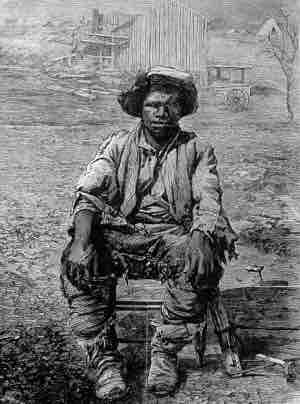Introduction
During the summer of 1800 in Richmond, Virginia, Gabriel Prosser, an enslaved literate blacksmith, planned a revolt that would come to be known as "Gabriel's Rebellion." Although plans of this uprising were leaked prior to their execution, the event highlighted the potential for slave-organized resistance and revealed inconsistencies within American ideals of freedom. It also had a massive impact on the treatment of slaves in the American South.

Gabriel Prosser
Image of Gabriel Prosser, leader of Gabriel's Rebellion in 1800.
Background
Numerous black slave rebellions and insurrections took place in North America during the seventeenth, eighteenth, and nineteenth centuries. Gabriel's uprising was notable not because of its results—the rebellion was quelled before it could begin—but because it demonstrated the potential for mass resistance and revolution. In 1800, nearly 40 percent of the total population of Virginia were slaves, concentrated on plantations in the Tidewater area and west of Richmond. This ratio made white slave owners in the region particularly fearful of revolts such as the Haitian Revolution that began in the 1790s.
In addition to the large numbers of enslaved African Americans, the increasing number of freed slaves in Virginia made the region ripe for rebellion. From 1780 to 1810, the number of slaves freed in the Upper South had grown markedly. The French and Haitian Revolutions had encouraged the emigration of many slave-owning whites and free people of color to the American South. This prompted an influx of both zealous slave owners and free African Americans, and the very existence of free African Americans in Richmond challenged the condition of Virginia as a slave state.
The Rebellion and Its Aftermath
On August 30, 1800, Prosser intended to lead slaves into Richmond, set fire to the city, and capture the governor, James Monroe. Information regarding the revolt was leaked prior to its execution, however, and Monroe called the state militia to action. Prosser and twenty-five followers were taken captive and hanged without trial.
Prosser had strategically planned the rebellion by using the relatively lax rules regarding the movement of slaves between plantations and the city: Many slaves were hired out as contracted hands, and others traveled to and from the city on errands for their masters. Prior to the rebellion, Virginia law also had allowed the teaching of slaves to read and write and had encouraged their training in skilled trades. After plans for the rebellion were quelled, many slave holders greatly restricted the slaves' rights of travel. Further, the Virginia Assembly in 1808 banned the hiring out of slaves, and the Emancipation Law of 1806 required freed blacks to leave the state within twelve months or face re-enslavement.
Prior to Gabriel's Rebellion, some Virginian slave owners were wary of the increasing number of free blacks and argued for stricter manumission laws. For many southern white slave owners, Gabriel's Rebellion proved that slaves would tend toward rebellion and resistance if not kept forcibly contained and controlled. Antislavery proponents, however, took it as proof of the inconsistencies of freedom within American society. For many slaves and free African Americans, the rebellion proved the power of strategic organization and resistance.